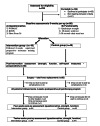The Efficacy of High-Intensity Preoperative Physiotherapy Training on Postoperative Outcomes in Greek Patients Undergoing Total Knee Arthroplasty: A Quasi-Experimental Study
- PMID: 35444879
- PMCID: PMC9010031
- DOI: 10.7759/cureus.23191
The Efficacy of High-Intensity Preoperative Physiotherapy Training on Postoperative Outcomes in Greek Patients Undergoing Total Knee Arthroplasty: A Quasi-Experimental Study
Abstract
Purpose: Several studies have shown that patients with severe osteoarthritis (OA) of the knee can reduce their knee pain, improve their quadriceps strength, and improve their functional ability through regular exercise training. The purpose of this study was to investigate the efficacy of a six-week supervised high-intensity preoperative training program on muscle strength, functional performance, and patient-reported outcomes in patients undergoing total knee arthroplasty (TKA).
Methods: Ninety-eight patients scheduled for unilateral TKA for severe OA were allocated to an intervention group (N = 49) who completed a six-week preoperative training program, five days per week prior to surgery, and a control group (N=49) who did not follow any preoperative training program. The Western Ontario and McMaster Universities Osteoarthritis Index (WOMAC), the Physical Functioning Scale of the Short Form-36 questionnaire (SF-36), Knee Injury and Osteoarthritis Outcome Score (KOOS), quadriceps strength, 20-meter walk test, and 30-second chair stand test were assessed at six weeks before surgery (T0), just before surgery (T1), four weeks (T2) and finally 12 weeks (T3) after TKA.
Results: Of 98 patients included in our study, 10 individuals withdrew from the study at different stages. Finally, 44 patients were allocated to the intervention group and 44 patients to the control group. When comparing the changes from baseline to the primary test points at T1, T2, and T3, we found a significant group difference in favor of the intervention group for quadriceps strength (<0.001, 0.001, 0.009), 20-meter walk test (<0.001, 0.023, 0.032), 30-second chair stand test (0.001, <0.001, <0.001) and all patient-reported outcomes WOMAC (<0.001, 0.001, 0.007) except from KOOS that showed significant difference only at T1 (<0.001) at T2 (0.048) but not at T3 (0.087).
Conclusions: Our study demonstrated that a six-week preoperative physiotherapy training program supervised by a physiotherapist before TKA is efficacious for decreasing knee pain, improving knee function, and enhancing daily living activities.
Keywords: knee function; osteoarthritis; physiotherapy; preoperative rehabilitation; total knee arthroplasty.
Copyright © 2022, Vasileiadis et al.
Conflict of interest statement
The authors have declared that no competing interests exist.
Figures
Similar articles
-
High-intensity preoperative training improves physical and functional recovery in the early post-operative periods after total knee arthroplasty: a randomized controlled trial.Knee Surg Sports Traumatol Arthrosc. 2017 Sep;25(9):2864-2872. doi: 10.1007/s00167-016-3985-5. Epub 2016 Jan 14. Knee Surg Sports Traumatol Arthrosc. 2017. PMID: 26768606 Clinical Trial.
-
Utilization of Blood Flow Restriction Therapy with a Former Triathlete After Total Knee Arthroplasty: A Case Report.Int J Sports Phys Ther. 2024 Sep 1;19(9):1138-1150. doi: 10.26603/001c.122488. eCollection 2024. Int J Sports Phys Ther. 2024. PMID: 39267627 Free PMC article.
-
The effect of a prehabilitation exercise program on quadriceps strength for patients undergoing total knee arthroplasty: a randomized controlled pilot study.PM R. 2012 Sep;4(9):647-56. doi: 10.1016/j.pmrj.2012.04.012. Epub 2012 Jun 13. PM R. 2012. PMID: 22698852 Clinical Trial.
-
A systematic review and meta-analysis of the effect of preoperative exercise intervention on rehabilitation after total knee arthroplasty.Ann Palliat Med. 2021 Oct;10(10):10986-10996. doi: 10.21037/apm-21-2670. Ann Palliat Med. 2021. PMID: 34763461
-
The effects of preoperative rehabilitation on pain and functional outcome after total knee arthroplasty: a meta-analysis of randomized controlled trials.J Orthop Surg Res. 2022 Mar 21;17(1):175. doi: 10.1186/s13018-022-03066-9. J Orthop Surg Res. 2022. PMID: 35313897 Free PMC article. Review.
Cited by
-
The Risk Factors and Preventive Strategies of Poor Knee Functions and Osteoarthritis after Anterior Cruciate Ligament Reconstruction: A Narrative Review.Phys Ther Res. 2023;26(3):78-88. doi: 10.1298/ptr.R0028. Epub 2023 Nov 25. Phys Ther Res. 2023. PMID: 38125289 Free PMC article. Review.
-
Supervised prehabilitation in patients scheduled for spinal surgery - a scoping review.Eur Spine J. 2025 Apr;34(4):1366-1385. doi: 10.1007/s00586-025-08710-6. Epub 2025 Feb 8. Eur Spine J. 2025. PMID: 39920321
-
An umbrella review for preoperative rehabilitation in primary total knee arthroplasty: quality assessment and summary of evidence.BMC Musculoskelet Disord. 2025 Jul 4;26(1):630. doi: 10.1186/s12891-025-08541-y. BMC Musculoskelet Disord. 2025. PMID: 40616021 Free PMC article.
-
Physical therapy as a promising treatment for osteoarthritis: A narrative review.Front Physiol. 2022 Oct 14;13:1011407. doi: 10.3389/fphys.2022.1011407. eCollection 2022. Front Physiol. 2022. PMID: 36311234 Free PMC article. Review.
-
Letter to the editor concerning "Effect of joint immobilization using extension splint immediately after total knee arthroplasty on post-operative knee function and pain: a randomized clinical trial".Int Orthop. 2023 Mar;47(3):893-894. doi: 10.1007/s00264-022-05667-9. Epub 2022 Dec 22. Int Orthop. 2023. PMID: 36547702 No abstract available.
References
-
- Osteoarthritis. Hunter DJ, Bierma-Zeinstra S. Lancet. 2019;27:1745–1759. - PubMed
-
- The prevalence of symptomatic knee osteoarthritis in China results from the China health and retirement longitudinal study. Tang X, Wang S, Zhan S, Niu J, Tao K, Zhang Y, Lin J. Arthritis Rheumatol. 2016;68:648–653. - PubMed
LinkOut - more resources
Full Text Sources

